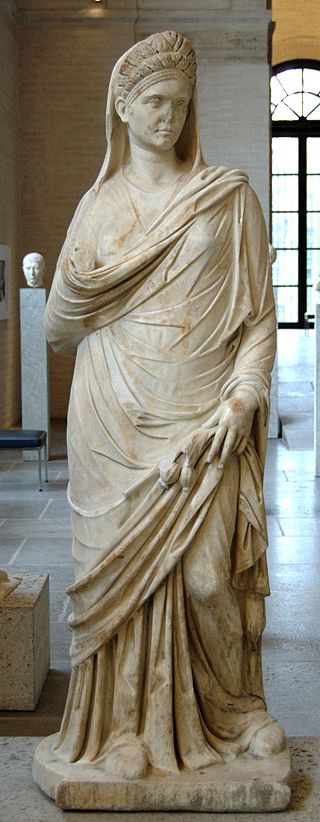Over the course of history there have been some figures who have distinguished themselves for their actions so much that they have became “examples” for other people. Considering the Roman world, we should remember some characters like Caesar, Pompeius, Augustus, but also Cleopatra, Agrippina and Poppea. However, there were also men and women who have been forgotten over time, even if their actions can be considered extraordinary. One of these figures id Maesia Sentinas, who lived during the first century B. C. We have little, rather very little information about this Ancient Roman woman. Infact, among the Latin authors only Valerius Maximus reports Maesia’s name in his Memorable Deeds and Sayings and describes an episode in which this woman was involved. Although Valerius doesn’t give a clear and complete summary of Maesia’s origins, we can deduce two things from the text: the woman’s native city (the Ancient Umbrian city of Sentinus, from which derives the appellative of Sentinas) and the period in which she lived, albeit in an approximate way. There is a reason why Valerius doesn’t concentrate on Maesia’s biography: he prefers to pay more attention on the action done by this woman because it isn’t in compliance with the social and cultural values of Ancient Rome. Infact, Maesia is one of those women who, as Valerius writes, condicio naturae et verecundia stolae ut in foro et iudiciis tacerent cohibere non valuit, “were restrained from speaking in the Forum and in the courts either by their sex or by the chastity of matronly dress” (Fact. mem. 8,3).
Women and courts in Ancient Rome: two separate worlds

First of all, in order to understand the peculiarity of Maesia’s action in the Roman mentality, it is necessary to remember that in Ancient Rome the male and female worlds were seen as two completely separate spaces. Women were primarily matrones, wifes and mothers, and their actions had to happen in the private and domestic sphere. As cives (“citizens”), men mainly had to dedicate themselves to public life, which involved the political and forensic activity. Ancient Romans didn’t appreciate the situations in which a woman attempted to “violate” the male sphere of action and, viceversa, if a man acted like a woman. Rather, when it happened, it was seen as a “disturbing” event, which could shake the social and cultural values of the citizens’ life. So, in according to this dichotomy, it was strictly forbidden for women to take part in public life and also attend the Forum and the courts, where political activity took place. Actually, women could physically enter these spaces, but she had to be accompanied by a guardian, usually a male member of her family, who spoke in her stead. Therefore, according to the dominant model of behaviour, women couldn’t express their own opinion in public, but they had to be completely silent. As a matter of fact, the Romans thought that women were characterized by impotentia, that is by their innate incapacity of self-control, and, for this reason, they were unable to correctly use the word, fine instrument of political debate. In mulieres’ hands, the word risked “getting dirty” and becoming impoverished, transforming it into useless and meaningless chatter. So, even when women saw their richness and culture increase, their presence in public life and its places were still restricted. However, sometimes this mental and cultural construction didn’t coincide with what happened in reality and Maesia’s episode proves this.
Read also:
The myth of Hermaphroditus: nec femina dici nec puer ut possit.
Maesia Androgynen: between praise and cultural “embarrassment”
Valerius Maximus writes this:
Maesia Sentinas rea causam suam L. Titio praetore iudicium cogente maximo populi concursu egit modosque omnes ac numeros defensionis non solum diligenter, sed etiam fortiter exsecuta, et prima actione et paene cunctis sententiis liberata est. Quam, quia sub specie feminae virilem animum gerebat, Androgynen appellabant (Fact. mem. 8, 3, 1).
“Because she had been accused, Maesia of Sentinum defended her own case, before a great crowd, at the court convened by the praetor Lucius Titius and, having used all the techniques and devices of defense not only accurately, but also courageously, she was acquitted at the first hearing and almost unanimously. So, because she concealed a manly spirit in the guise of a woman, they call her Androgynous”.

As we can see, Maesias defended herself in the court without the mediation of a man, this way violating the social and cultural principles. However, Valerius doesn’t disapprove of Maesia’s behaviour, but acclaims the accuracy of her discourse and admires her courage. On the basis of what up to now I have described, how is it possible that the author doesn’t openly blame the action of this woman? To answer this question, it is necessary to analyse Maesia’s action considering the context in which it is collocated. So, we can ask ourselves another question: why there wasn’t any man who could defend Maesia in the court? Valerius didn’t explain the reason why Maesia didn’t have any guardian, but we can speculate on the basis of the time when the trial happened. Maesia lived in the first half of the first century B.C., a period of serious social and political crisis for Roman state. The Social War, Sulla’s dictatorship, the insurrections of Lepidus, Sertorius and Catiline had decimated the male population and this had impeded the usual presence of men in particular spheres of public life. In addition, it is probably that the men of Maesia’s family ware involved in the great Umbrian revolt of 90 B.C. For this reason, they couldn’t defend the woman in the court as her guardians. In according to this reconstruction, Maesia shouldn’t have defended herself, but she was a victim of circumstances, forced to defend herself in an irregular situation for the Roman mentality and law. However, Maesia’s action shouldn’t be praised for itself because it was always a violation of the mental, social and cultural schemes. Infact, Valerius doesn’t blame the woman, but he doesn’t praise her action; rather, the author gives a bland justification to explain the peculiar and “outside the box” situation that happened. So, the figure of Maesia is in a border area: her action cannot be considered negative because it is imposed by an extraordinary situation, but it cannot either be considered positive on the basis of what I have previously said. So, all of this creates a sort of “cultural” embarrassment, a situation in which a behaviour can be justifiable, but not acceptable because of dominant social and cultural values. This “short circuit” between reality and mental schemes is highlighted by Valerius with the reference to the nickname attributed to Maesia, that is Androgynen: a woman who, even if she has demonstrated the same courage as a man, violates the world of courts that she shouldn’t enter.
Maesia the Androgynous: a warning for the present

Although Maesia’s episode is quite defined and little known, it leads us to reflect on particular aspects of present day reality. First of all, it is necessary to evaluate an action in the context in which it has been caused, in order to judge that action in the best possible way. Then, Maesia’s episode shows how sometimes some social and mental constructions are so rooted in us that they confuse our critical judgment. In this social era, it is not rare that a person is attacked and blamed at first glance because of particular ideas which make us not very flexible and inclined to tolerance. In conclusion, the figure of Maesia belongs to that crowd of historical “ghosts” whose actions are an example for the present generations. So, it is a good thing to search and analyse the life and the actions of these characters so that they can be fully remembered and kept from oblivion.
My sources are:
- Eva Cantarella, Passato prossimo: Donne romane da Tacita a Sulpicia, Milano, Feltrinelli Editore, 2016.
- Anthony J. Marshall, Roman Ladies on Trial: The Case of Maesia of Sentinum, “Phoenix”, 44 (1990), pp. 46-59.

Un commento Aggiungi il tuo